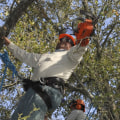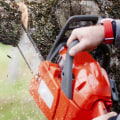Having a lush landscape around your property can be stunning. Everyone loves having trees in their yard. Over time, the trees you own may begin to feel like they are part of your family. They shade us in the summer and we see them grow and develop over time.
We welcome their new buds in spring and watch the beautiful spectacle of their leaves that change in autumn. Over the years, trees appear in our photos and become part of many of our memories. When one of our trees dies, it leaves sorrow in our hearts. The most notorious sign that there is something wrong with a tree are its branches. If you see fungi, such as mushrooms, growing on the bottom of your tree, it may be slowly dying.
Moss is not a problem; many healthy trees may be covered with moss. However, if you start to see rapid fungal growth on the trunk or along root paths, your tree is likely struggling to stay alive. Root rot can also be a problem. You can tell if the roots of your tree are rotting because holes and holes will appear in the lawn.
More fungi will grow on dead roots as they break them down for fuel. If your tree is feeling stressed, it can start sending buds from its base or from other lower parts of the tree. These sprouts may indicate that your tree is doing everything it can to survive. When the upper branches die, new growth can be a desperate effort to start over. When a tree struggles to stay alive, leaves can tell a lot.
Trees that are not healthy may have much fewer leaves than other trees that are nearby, and leaves that grow may have a completely different shade than normal. When autumn comes, if the tree does not shed dead leaves, that may be another sign that the tree is also sick. It may appear to be dead, but it may also be inactive. Or maybe only one section of the tree is dead, with only a few branches affected. To avoid these problems, it is essential to cut down trees that have more negative effects than benefits on your property.
In this regard, here is a guide on when to cut down a tree in your garden. Trees with invasive roots may need to be cut, especially if invasive roots cannot be removed without compromising the health of the tree. If 50% of the tree is damaged, it should probably be removed. A decaying tree may continue to survive for many years, but it will always have limited or abnormal growth and appearance. Trees that have been damaged by herbicide often have deformed leaves, but they can often recover. While cracks, crevices and cavities in the trunk may indicate that a tree is no longer structurally sound, cavities do not necessarily mean that a tree must be removed.
However, the extent of cracks and cavities in the trunk of a tree should be examined. A professional tree expert will know if a cavity or crack has become too large for the tree to hold. In addition, trucks also contain the most obvious clues of a dead, infested, sick or rotten tree. A clear indicator of all these things may be that the trunk is missing large pieces of bark. It's no secret that I love trees, and I usually discourage you from removing a tree.
But there are some situations in which a tree must be cut. Uprooted trees can cause a blockage in the street, damage the house or interfere with electrical cables. Again, disputes may arise if tree branches hang over the neighbor's property and result in damage. But sometimes trees can get sick, die, or simply become a big risk to the safety of your loved ones and even your neighbors. A situation that follows the old and outdated practice of “covering trees” is the rupture of regrowth.
Sudden branch fall syndrome can occur even in trees that are completely healthy and is especially prevalent in oaks, beeches, elms, eucalyptus and sycamore trees. A tree expert will always try to save any tree that has been damaged by a storm but will sometimes recommend that you remove it. And there is no doubt that the fall of a dead tree or even a branch can cause considerable damage to houses, cars or even people nearby. Therefore, there are no good strict and fast rules about when a tree should be removed or when it should remain. In other words, if the roots of your tree are close to the surface and the roots of other nearby trees are not, your tree may be struggling to stay alive. What I usually say is that if he is back in the woods and no one is going to get hurt by this tree if he falls let him. It is difficult to see such a large and imminent presence disappear and as a result many people postpone tree removal projects for many years. Trees in the forest grow very well together; therefore planting shade trees in groves that replicate nature is fine.


